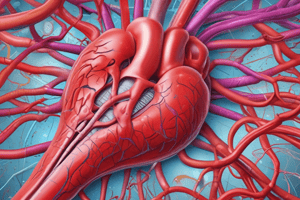Podcast
Questions and Answers
Which organ plays the dominant role in long term regulation of arterial pressure and hypertension?
Which organ plays the dominant role in long term regulation of arterial pressure and hypertension?
- Lungs
- Kidney (correct)
- Heart
- Liver
What is the main mechanism of short term control of arterial pressure?
What is the main mechanism of short term control of arterial pressure?
- Nervous system influence on resistance
- Nervous system influence on capacitance
- Nervous system influence on cardiac pumping action
- All of the above (correct)
What happens to urinary output as arterial pressure increases?
What happens to urinary output as arterial pressure increases?
- Urinary output decreases
- Urinary output increases (correct)
- Urinary output remains constant
- Urinary output is not affected by arterial pressure
What is the term used to describe the increase in urinary output as pressure rises?
What is the term used to describe the increase in urinary output as pressure rises?
At what arterial pressure is there no urine output?
At what arterial pressure is there no urine output?
What happens to urinary volume output and sodium output as arterial pressure increases?
What happens to urinary volume output and sodium output as arterial pressure increases?
Which of the following is a key determinant of extracellular fluid volume?
Which of the following is a key determinant of extracellular fluid volume?
What is the effect of volume loading on blood pressure?
What is the effect of volume loading on blood pressure?
What happens when animals are given a salt solution to drink instead of water?
What happens when animals are given a salt solution to drink instead of water?
What is the effect of reduced renal mass on blood pressure?
What is the effect of reduced renal mass on blood pressure?
What is the role of the renin-angiotensin system in blood pressure control?
What is the role of the renin-angiotensin system in blood pressure control?
What does Angiotensin II stimulate in the kidney?
What does Angiotensin II stimulate in the kidney?
Which of the following is the primary cause of essential hypertension?
Which of the following is the primary cause of essential hypertension?
What happens when there is a rightward shift in the 'Sodium-loading renal function curve'?
What happens when there is a rightward shift in the 'Sodium-loading renal function curve'?
What is the role of the kidneys in regulating arterial pressure?
What is the role of the kidneys in regulating arterial pressure?
What is the effect of small changes in volume and pressure on renal output?
What is the effect of small changes in volume and pressure on renal output?
Which system dominates the other pressure control mechanisms for long-term pressure control?
Which system dominates the other pressure control mechanisms for long-term pressure control?
What is the effect of a leftward shift of the renal output curve?
What is the effect of a leftward shift of the renal output curve?
Which of the following is a direct effect of angiotensin II on the kidney?
Which of the following is a direct effect of angiotensin II on the kidney?
What is the main effector in the Renin Angiotensin System?
What is the main effector in the Renin Angiotensin System?
What is the role of the Renin Angiotensin System in protecting against falls in arterial pressure?
What is the role of the Renin Angiotensin System in protecting against falls in arterial pressure?
What happens to the renal output curve when angiotensin II is infused?
What happens to the renal output curve when angiotensin II is infused?
What is the main characteristic of primary essential hypertension?
What is the main characteristic of primary essential hypertension?
Why is it important to measure a patient's blood pressure in a dental office?
Why is it important to measure a patient's blood pressure in a dental office?
Which of the following is true about the equilibrium point of the renal output curve and net water and salt intake?
Which of the following is true about the equilibrium point of the renal output curve and net water and salt intake?
What are the two ways to raise arterial pressure and change the equilibrium point?
What are the two ways to raise arterial pressure and change the equilibrium point?
What does a steeper chronic renal output curve indicate?
What does a steeper chronic renal output curve indicate?
What does the equation P = F x R represent?
What does the equation P = F x R represent?
What happens when there is an increase in total peripheral resistance (TPR)?
What happens when there is an increase in total peripheral resistance (TPR)?
What is more likely to raise arterial pressure: increased salt intake or increased water intake?
What is more likely to raise arterial pressure: increased salt intake or increased water intake?
Flashcards are hidden until you start studying

